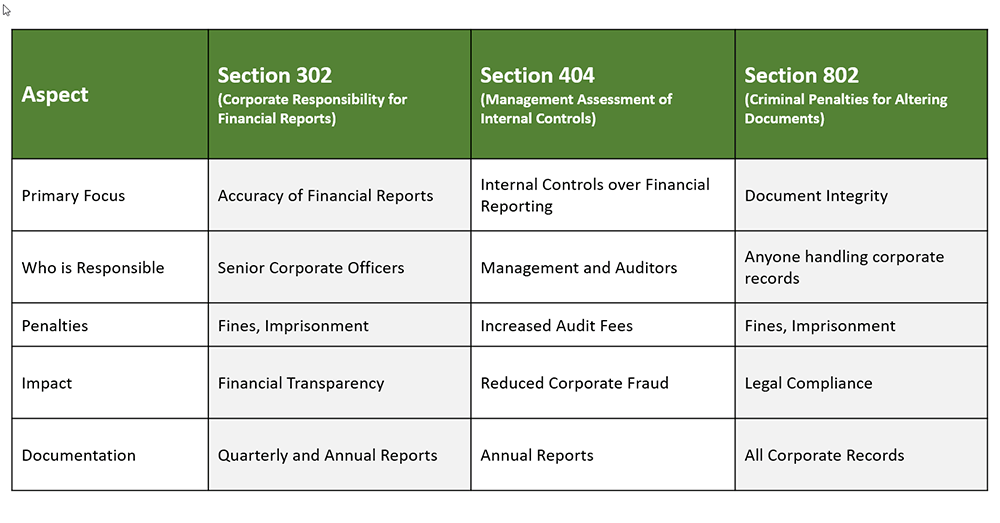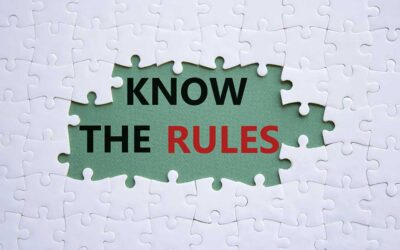The Sarbanes-Oxley Act, commonly called SOX, didn’t just appear out of thin air. Its inception can be traced back to a period of corporate malfeasance that shook the very foundations of the American financial system. The Enron scandal, which unfolded in the early 2000s, was the catalyst that led to the creation of this landmark legislation. Enron, once a darling of Wall Street, imploded due to fraudulent accounting practices, leaving shareholders and employees in financial ruin.
The public outcry was deafening, and it became abundantly clear that legislative action was needed to restore faith in the corporate governance system. Enter the Sarbanes-Oxley Act of 2002, named after its architects, Senator Paul Sarbanes and Representative Michael Oxley. The legislation was signed into law by President George W. Bush on July 30, 2002, with the primary aim of increasing corporate financial reporting transparency.
The act bestowed the Securities and Exchange Commission (SEC) with the authority to create regulations to govern corporate conduct. These regulations were designed to hold corporations accountable, protecting investors from fraudulent activities like the Enron debacle.
Understanding the origins of SOX compliance provides valuable context for why current regulations are as stringent as they are. It’s not just about ticking off boxes in a compliance checklist; it’s about ensuring the corporate world operates on a foundation of trust and ethical conduct. The Enron scandal was a cautionary tale, and SOX emerged as the legislative response to prevent history from repeating itself.
The Legal Framework of SOX
SOX is a set of guidelines and a legal framework that companies must adhere to. Enforced by the Securities and Exchange Commission (SEC), SOX compliance is a non-negotiable aspect of corporate governance in the United States. The SEC has the authority to impose penalties, fines, and even imprisonment for non-compliance, making it imperative that companies understand the legal ramifications thoroughly.
One of the most daunting aspects of SOX compliance is the potential for legal repercussions. Companies violating SOX can face severe penalties, including fines that can run into millions of dollars. In extreme cases, corporate executives may even face imprisonment. To provide a clearer picture, a table detailing the penalties and fines associated with various levels of SOX non-compliance could benefit the reader.
The SEC plays a pivotal role in the enforcement of SOX compliance. It has the authority to investigate companies and, if necessary, bring civil suits against them. Moreover, the SEC can also issue cease-and-desist orders, suspending or revoking the registration of a broker, investment advisor, or even an entire company.
The legal framework surrounding SOX compliance is intricate and laden with potential pitfalls. Companies must exercise due diligence and adopt a proactive approach to compliance to mitigate the risk of legal consequences. Understanding the role of the SEC and the penalties for non-compliance is not just advisable; it’s essential for any company operating in today’s regulatory environment.
SOX Compliance: The Core Sections
Regarding SOX compliance, three sections often stand out as the backbone of the legislation—Sections 302, 404, and 802. These sections are not just statutory requirements; they serve as the cornerstone for transparent and ethical corporate governance.
Section 302 – Corporate Responsibility for Financial Reports
This section mandates that senior corporate officers take individual responsibility for the accuracy and completeness of corporate financial reports. It’s not just about signing off on documents; it’s about ensuring that those documents faithfully represent the company’s financial health. Failure to comply can result in severe penalties, including imprisonment.
Section 404 – Management Assessment of Internal Controls
Arguably the most talked-about section, Section 404 requires companies to include a report on internal controls over financial reporting in their annual reports. This section has led to a significant increase in audit fees but has also been credited with reducing corporate fraud. Companies must establish adequate internal controls and regularly test these controls to ensure their effectiveness.
Section 802 – Criminal Penalties for Altering Documents
This section criminalizes the act of altering, destroying, or even falsifying records in federal investigations. The implications are far-reaching, affecting financial documents, emails, and other electronic records.
The Corporate Landscape Post-SOX
The Sarbanes-Oxley Act of 2002 (SOX) has significantly impacted corporate America. One of the most significant shifts has been in the area of accountability. Before SOX, the onus of financial missteps often fell on lower-level employees, while C-suite executives remained largely unscathed. SOX changed this by holding senior executives accountable for the accuracy of financial statements, thereby elevating the importance of ethical leadership.
Another area where SOX has left an indelible mark is transparency. Companies must now disclose more information than ever, including off-balance-sheet items and transactions involving executive officers. This has increased the workload for compliance teams and made corporations more transparent to investors and stakeholders.
SOX has also led to a surge in the demand for internal auditors and compliance officers. According to the U.S. Bureau of Labor Statistics, the employment of compliance officers is expected to grow 6% from 2019 to 2029, faster than the average for all occupations. This underscores the critical role these professionals play in maintaining corporate integrity.
However, SOX has not been without its challenges. The cost of compliance has been a point of contention. A survey by Protiviti and North Carolina State University’s ERM Initiative found that public companies with revenues less than $100 million spend an average of $1.5 million annually on SOX compliance. While the benefits of SOX are undeniable, the financial burden it places on smaller companies cannot be overlooked.
Overall, the post-SOX corporate landscape is one of increased accountability, transparency, and regulatory scrutiny. While the act has fortified corporate governance structures, it has also imposed new challenges that companies must navigate carefully. Balancing compliance with operational efficiency is the key to thriving in this new environment.
Harnessing Tech for SOX Compliance
Technology plays an indispensable role in ensuring SOX compliance. Gone are when compliance was managed through cumbersome paper trails and manual audits. Today, a plethora of software solutions exist to streamline this complex process, making it more efficient and less prone to human error.
Automating Financial Reporting
One of the most critical aspects of SOX compliance is accurate financial reporting. Software solutions like Workiva and FloQast offer automation features that significantly reduce the time and effort required to compile financial statements. These platforms have built-in analytics tools to flag inconsistencies or errors, allowing for real-time corrections.
Data Security and Integrity
SOX mandates stringent data protection measures to prevent fraud. Technologies like encryption and multi-factor authentication are now standard features in compliance software. Platforms such as Varonis and McAfee Total Protection offer robust security features that safeguard sensitive financial data, aligning with SOX requirements.
Audit Trails and Documentation
Maintaining a detailed audit trail is a cornerstone of SOX compliance. Software solutions like AuditBoard and LogicGate offer features that automatically log all changes made to financial records. This ensures transparency and simplifies the audit process, as auditors can easily trace each transaction’s history.
Cloud-Based Solutions
The advent of cloud technology has revolutionized SOX compliance management. Cloud-based platforms offer remote access, making collaboration easier for teams spread across different locations. Moreover, updates and patches can be rolled out more swiftly, ensuring compliance software stays current with any changes in SOX regulations.
Choosing the Right Software
Selecting the appropriate SOX compliance software is crucial. Companies should consider factors such as scalability, ease of use, and the quality of customer support when making their choice. Many platforms offer free trials, allowing companies to test the software’s capabilities before committing financially.
Technology has emerged as a vital ally in achieving SOX compliance. From automating financial reports to ensuring data security, modern software solutions offer a range of features that simplify and enhance the compliance process. As SOX regulations continue to evolve, one can expect technology to keep pace, offering ever-more sophisticated solutions for compliance management.
SOX Compliance and Private Equity
A recent Forbes article sheds light on the new SEC rules that redefine the landscape of private equity fees. These rules are part of a broader regulatory push to bring greater transparency and accountability to alternative investments, including private equity. While the primary focus of SOX is to prevent fraudulent activities in public companies, its principles of transparency, accountability, and internal controls are increasingly relevant to private equity firms.
Private equity firms often manage substantial assets, and their investment activities can significantly impact the market. As these firms enter defined contribution (DC) retirement plans, the need for stringent compliance mechanisms akin to SOX, becomes evident. The new SEC rules aim to ensure that private equity fees are transparent and justified, thereby protecting the interests of investors.
What does this mean for private equity firms? Firstly, they may need to revamp their internal control mechanisms to align with SOX-like standards, especially in financial reporting and disclosures. Secondly, the firms will likely need to invest in compliance software and tools that can help them meet these standards efficiently. Lastly, the C-suite executives of private equity firms should be prepared for increased accountability, as the new rules could entail stringent penalties for non-compliance.
While SOX was initially designed for public companies, its principles are becoming increasingly applicable to private equity firms, especially after new SEC rules. Adherence to SOX compliance mitigates risks and adds a layer of credibility that can be beneficial in attracting investments. Therefore, private equity firms would do well to adapt to these evolving compliance landscapes proactively.
The Global Reach of SOX
In an increasingly globalized business environment, SOX has become a benchmark for corporate governance worldwide. Companies operating in multiple countries often adhere to SOX-like regulations, even if local laws do not mandate them.
Take, for instance, the United Kingdom’s Companies Act of 2006. This legislation echoes many of SOX’s governance and financial reporting requirements. Similarly, the European Union’s 8th Company Law Directive, often called “Euro-SOX,” aims to improve the integrity of financial information disclosed by companies listed on European stock exchanges.
Another example is Japan’s Financial Instruments and Exchange Law, colloquially known as J-SOX. Modeled after its American counterpart, J-SOX mandates internal controls over financial reporting, much like Sections 302 and 404 of the Sarbanes-Oxley Act.
The global reach of SOX is not just limited to developed economies. Emerging markets like India and Brazil have also introduced corporate governance norms inspired by SOX. These countries recognize the value of stringent financial controls in attracting foreign investment and fostering economic growth.
However, it’s essential to note that while SOX has inspired similar laws globally, the level of enforcement and penalties for non-compliance can vary significantly from one jurisdiction to another. Companies operating internationally should be aware of these nuances and consult legal experts to navigate the complex web of global corporate governance.
Practical Steps for SOX Compliance
Navigating the intricate requirements of SOX compliance can be daunting for any organization. However, with a structured approach, companies can meet these requirements and improve their internal controls and financial reporting processes. Here’s a step-by-step guide to help organizations chart their course to SOX compliance.
1. Assemble a SOX Compliance Team
This team should comprise individuals from various departments, including finance, IT, and legal. Their primary role is to oversee the implementation of SOX compliance measures.
2. Conduct a Risk Assessment
Identify areas within the organization that are most susceptible to financial inaccuracies or fraud. This assessment will guide the focus of your compliance efforts.
3. Document Internal Controls
Every process related to financial reporting must be documented meticulously. This includes everything from how transactions are initiated to how they are recorded and reviewed.
4. Implement Control Measures
Based on the risk assessment, introduce control measures to mitigate identified risks. This could range from segregating duties to implementing advanced security protocols for financial systems.
5. Test the Controls
Before these controls can be deemed effective, they must be tested rigorously. This often involves both automated and manual testing methods.
6. External Audit
Hire an external auditor to review your internal controls and financial statements. Their independent assessment is crucial for SOX compliance.
7. CEO and CFO Certification
The CEO and CFO must certify that the financial statements are accurate and that effective internal controls are in place. This is a key requirement under SOX Section 302.
8. Ongoing Monitoring
SOX compliance is not a one-time event but an ongoing process. Regularly review and update internal controls, especially when there are significant changes like mergers, acquisitions, or the introduction of new financial systems.
9. Employee Training
Ensure that all employees know SOX compliance requirements and the importance of adhering to internal controls. Regular training sessions can help in this regard.
10. Record-Keeping
-Maintain all documentation related to SOX compliance for at least five years. This includes audit trails, certifications, and test results.
By following these steps, organizations can achieve SOX compliance and foster a culture of transparency and accountability. It’s a win-win situation for both the company and its stakeholders.





